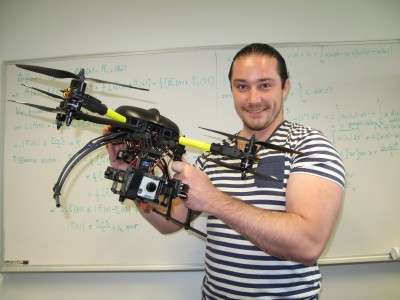Harnessing robot research a searching task

A new laboratory dedicated to technologies at the cutting edge of an emerging field of robotics could radically improve the way search and rescue operations are conducted. The Monash Swarm Robotics Laboratory – to be administered by the Faculty of Information Technology – will collaborate with the Wireless Sensors and Robot Networks (WSRN) Laboratory to produce swarm robotics technologies.
Swarm robotics makes use of principles observed in biological systems, such as insect colonies, flocks of birds, schools of fish, bacteria colonies, cells in human or animal bodies, and physics to coordinate the behaviour of groups of robots.
Co-director of the WSRN, Dr Jan Carlo Barca, who has been researching swarm robotics for the past four years, is developing technologies that can be used to search for objects, people and phenomena in general – such as pollution.
"We have chosen to focus on search and rescue in disaster sites, as this will enable us to assist rescue workers in saving human lives," Dr Barca said.
At the moment, the particular emphasis for the technology will be in aiding rescue workers tasked with locating people in GPS-denied environments. Environments of interest include regions where smoke obstructs the view from satellites, partially collapsed buildings, regions that are covered by clouds, tunnel systems and urban environments where human-made structures impede the view from the sky.
Dr Barca and his team are developing technologies that enable groups of flying and ground-moving robots to coordinate their behaviours - using wireless communication technology - and transmit information about their environment back to a base station, which could be located far away from where the robots are operating.
Dr Barca predicted that over the next 20 years swarm robotics will evolve in such a way that humans will be able "feel present" at a remote location via robots, and even experience a phenomenon known as 'multi-presence'.
"If there were multiple robots then you could be made to feel that you are at the locations of all the robots simultaneously, hence multi-presence. One simple example is when a guard in a control room looks at many screens that display live footage captured from multiple security cameras."
His shorter term hope is that by next year the technology will be advanced enough to carry out tasks that can aid in search and rescue efforts.
"This new technology will enable the search for natural resources, people and pollution, or the exploration of remote and dangerous environments, to be conducted effectively, without exposing humans to danger," Dr Barca said.
"It will enable us to shape our environments more efficiently than ever before and to exploit the sensing capabilities of large groups, which means that one can find areas of interest quickly, decide whether to enter them, and quickly determine when to leave."
Provided by Monash University



















